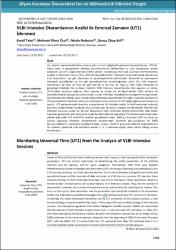| dc.contributor.author | Teke, Kamil | |
| dc.contributor.author | Öcal, Mehmet Fikret | |
| dc.contributor.author | Nohutcu, Metin | |
| dc.contributor.author | Okay Ahi, Gonca | |
| dc.date.accessioned | 2018-06-22T10:10:13Z | |
| dc.date.available | 2018-06-22T10:10:13Z | |
| dc.date.issued | 2017 | |
| dc.identifier.uri | http://fenbildergi.aku.edu.tr/wp-content/uploads/2017/12/035502-1004-1018.pdf | |
| dc.identifier.uri | http://hdl.handle.net/11630/4834 | |
| dc.description.abstract | Yer yönelim parametrelerinden zamana göre en hızlı değişkenlik göstereni Evrensel Zaman, UT1’dir.
Yapay uydu ve gezegenlerin yörünge parametrelerinin belirlenmesi ve uzay navigasyonu amaçlı
çalışmalar için UT1 vazgeçilmez bir öneme sahiptir. Uluslararası VLBI (çok uzun baz interferometrisi)
Jeodezi ve Astrometri Servisi (IVS), UT1’i belirleyebilmek için “Intensive” oturumlar olarak adlandırılan
VLBI oturumlarını her gün planlamak ve gerçekleştirmekle yükümlüdür. Ekonomik ve operasyonel
anlamdaki güçlüklerden ve her gün gerçekleştirilme zorunluluğundan ötürü IVS, VLBI Intensive
oturumlarını bir veya en fazla iki saat süre ile ve iki veya en fazla üç VLBI radyo teleskobu ile
gerçekleştirmektedir. Bu kısıtlayıcı faktörler VLBI Intensive oturumlarında ölçü sayısının az olması
(15-55 ölçü) sonucunu doğurur. Ölçü sayısının az olması ise, en-küçük-kareler (EKK) yöntemi ile
kestirilebilecek bilinmeyen parametre setini kısıtlar. VLBI ölçü modelinde öncül değerlerine sabit alınan
parametrelerdeki hatalar veya modele dâhil edilemeyen parametreler (örneğin, troposfer gradyanları)
UT1 parametresinin kestirim sonuçlarına olumsuz olarak yansırlar ve UT1 doğruluğunun azalmasına yol
açarlar. UT1 parametresinin Intensive oturumlarının IVS standart analizi ile belirlenmesinde yukarıda
belirtilen problemlerden hareketle, bu çalışmada yeni bir analiz stratejisi önerilmektedir. Önerilen IVS
Intensive oturumu analizi ile, Küresel Navigasyon Uydu Sistemleri (GNSS) ölçülerinden elde edilen
troposfer gradyanları VLBI ölçülerinin analizine dahil edilerek doğruluğu IVS standart analizinden daha
yüksek doğruluklu UT1 (YeniUT1) kestirimi gerçekleştirilmiştir. 2008 yılı başından 2017 yılı Ocak ayı
sonunu kapsayan Intensive oturumlarının analizlerinden kestirilen gün-uzunlukları ile GNSS
gün-uzunluklarının istatistiksel karşılaştırılmaları sonucu, YeniUT1 gün-uzunluklarının doğruluklarının
IVS standart analizi ile elde edilenlere kıyasla 2 ila 3 mikrosaniye/gün daha yüksek olduğu ortaya
konulmuştur. | en_US |
| dc.description.abstract | Universal Time (UT1) is the most variable parameter with respect to time among the Earth orientation
parameters. UT1 has utmost importance for determining the orbital parameters of the artificial
satellites and the planets, and for space navigation. International VLBI (Very Long Baseline
Interferometry) Service for Geodesy and Astrometry (IVS) is in charge of planning and realizing exclusive
VLBI sessions everyday, so-called Intensive sessions. Due to the drawbacks arising from economic and
operational issues and the necessity of daily realization of VLBI Intensive sessions, IVS operates these
sessions with two to three VLBI radio telescopes over one or two hours. These restrictions result in a
limited number of observations (15-55 observations) in an Intensive session. Thus, the few number of
observations constraint the number of parameters to be estimated by the Least-Squares method. The
errors of the a priori fixed parameters and the parameters that cannot be included in the observation
model (e.g. troposphere gradients) propagate into UT1 estimate and cause UT1 accuracy to decrease.
Concerning the above-mentioned restrictions for the UT1 estimation of IVS standard analysis, a new
analysis strategy is recommended in this study. In the scope of the new analysis strategy of IVS Intensive
sessions, the troposphere gradients from Global Navigation Satellite Systems (GNSS) are assimilated
into the analysis of VLBI Intensive sessions that result in more accurate UT1 estimates, i.e. New UT1,
than those derived by IVS standard analysis. Based on the statistical comparisons of the length-of-day
(LOD) estimates of the Intensive sessions, observed from the beginning of 2008 till the end of January
2017, with the GNSS LOD, it is proved that the LOD computed from New UT1 estimates have 2 to 3
microseconds/day better accuracies than those estimated from the IVS standard analysis. | en_US |
| dc.language.iso | tur | en_US |
| dc.publisher | Afyon Kocatepe Üniversitesi | en_US |
| dc.identifier.doi | 10.5578/fmbd.66131 | en_US |
| dc.rights | info:eu-repo/semantics/openAccess | en_US |
| dc.subject | Evrensel Zaman | en_US |
| dc.subject | UT1 | en_US |
| dc.subject | Gün-uzunluğu | en_US |
| dc.subject | Troposfer gradyanları | en_US |
| dc.subject | VLBI | en_US |
| dc.subject | GNSS | en_US |
| dc.title | VLBI Intensive Oturumlarının Analizi ile Evrensel Zamanın (UT1) İzlenmesi | en_US |
| dc.title.alternative | Monitoring Universal Time (UT1) from the Analysis of VLBI Intensive Sessions | en_US |
| dc.type | article | en_US |
| dc.relation.journal | Fen ve Mühendislik Bilimleri Dergisi | en_US |
| dc.department | Afyon Kocatepe Üniversitesi | en_US |
| dc.identifier.volume | 17 | en_US |
| dc.identifier.startpage | 1004 | en_US |
| dc.identifier.endpage | 1018 | en_US |
| dc.identifier.issue | 3 | en_US |
| dc.relation.publicationcategory | Makale - Ulusal Hakemli Dergi - Kurum Yayını | en_US |



















